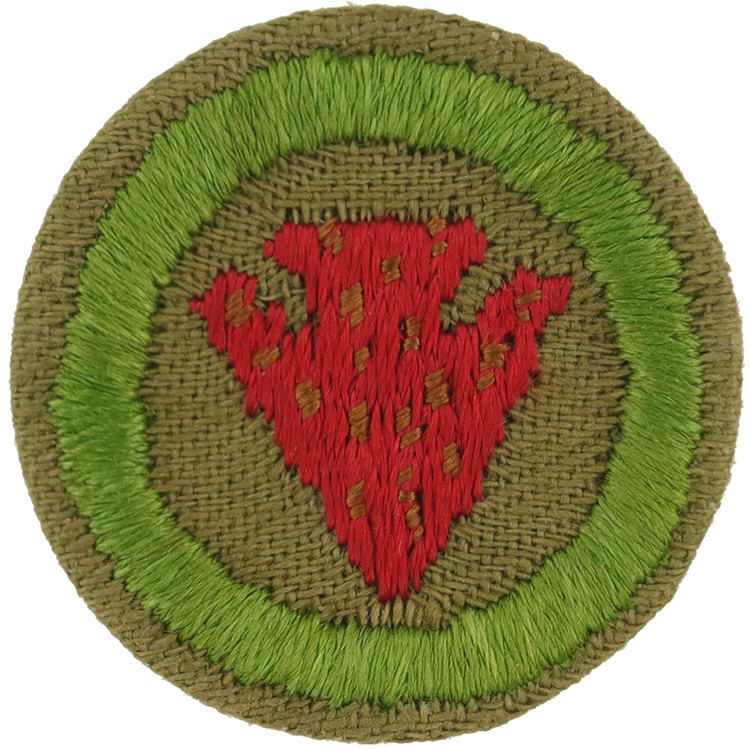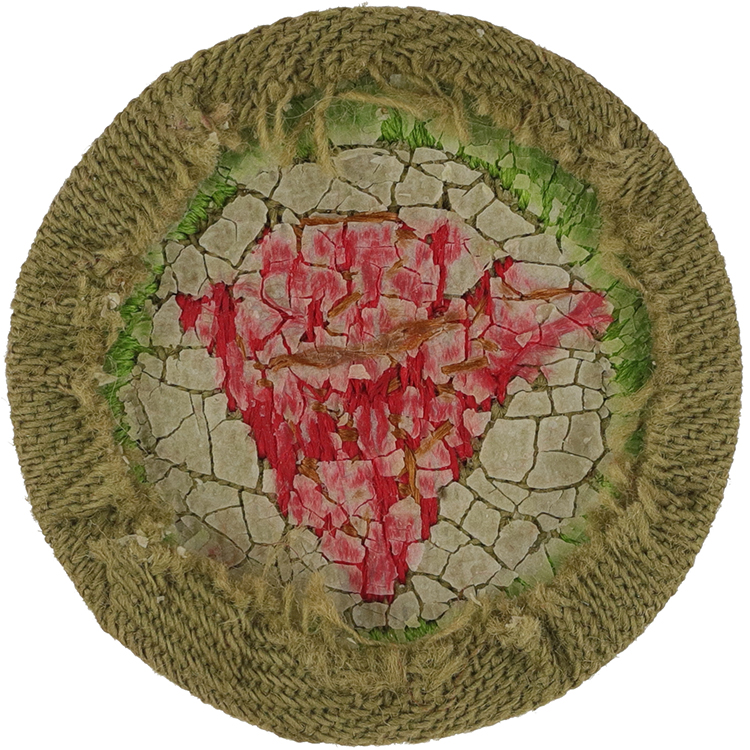
Fig. 1: IndLor-D3-Front
- Cloth: War
- Embroidery: Cotton continuous

Fig. 2: IndLor-D3-Reverse
- Back: Plain NO imprint with starch
Item Name: Indian Lore 1942 - 1945
Item ID: IndLor-D3
Collector Rating: 1
Requirements March 1931 until January 1960
1. Give history of the Indian Tribe that once lived nearest his home, telling something of their customs and habits, where the survivors remain, and their present condition. Visit them is possible.
2. Make an Indian costume complete and correct as to detail for one of the tribal groups, to consist of head-dress, shirts, leggings or kilt, and moccasins.
OR
Make and decorate authentically three of the following articles, using Indian methods in so far as possible; drum (ton-tom), rattle, bow and arrows, quiver, coup stick, or lance, pipe, pipe bag, belt, war bonnet, crow belt or "bustle", war club, totem pole, council seat or canoe paddle.
3. Make a model of a tepee, or of any other type of Indian dwelling.
4. Take part in an Indian Pageant, entertainment, or camp fire ceremonial in which at least three dances based on authentic Indian themes are used.
5. Sing three Indian songs including the Omaha Tribal Prayer and tell something of their meaning.
6. Demonstrate three Indian games that can be played in camp or at meetings.
7. Know at least fifty signs in the Indian Sign Language and with them carry on a conversation for three minutes, or tell a story in sign talk that will take at least that much time.
Requirements January 1960 until September 1962.
1. Give the history of one Indian tribe, tribal group, or nation, preferably one that lives or has lived near your home. Visit it, if possible. Tell something about each of the following: Dwellings, foods, food preparation, dress, religious beliefs, type of life (farmers, wanderers, etc.), language, warfare, means of transportation, where the survivors, if any, now live and how they now live.
2. Do two: (a) Make any Indian costume complete and as authentic as possible. (b) Make and decorate authentically any three Indian articles approved by your merit badge counselor. Such articles might include a drum (tom-tom), drumsticks, rattle, bow and arrows, quiver, coup stick or lance, shield, pipe, pipe bag, war bonnet, belt or dance bustle, war club, canoe paddle, totem pole. (c) Make an authentic model of an Indian dwelling that was used by any Indian tribe, tribal group, or nation. (d) On some former Indian site, with permission (and accompanied by a qualified archaeologist), find at least five Indian artifacts and identify them by shape, material, and site. Explain their use.
3. Do one: (a) Learn at least three authentic Indian games. Teach and lead one game with your patrol, troop, or post. (b) Learn and demonstrate Indian-style cooking. Cook at least three items. (c) With an adult counselor, learn and demonstrate Indian-style hunting, fishing, or trapping.
4. Do one: (a) Take part in Indian entertainment, pageant, or ceremonial in which dances and songs based on authentic Indian themes are used. (b) Sing at least two Indian songs in Indian dialect. Explain their meaning. (c) Plan, rehearse, and take part in an Indian campfire ceremony based on an authentic Indian theme. (d) Learn in Indian dialect at least twenty-five common terms and their meaning. (e) Know at least twenty-five signs in Indian sign language, including those that will help you ask for water, food, and where the trail or road leads. (f) Learn in English at least one Indian saga of not less than three hundred words, or any number of shorter ones totaling at least three hundred words. Relate the saga to a group around a campfire or at a troop or post meeting. (g) Write or tell about eight items adopted by the white man from the Indian. Such items might include food, clothing, medicines, crafts, games, cooking techniques, etc. (h) Learn at least twenty-five Indian place names, their origin and meaning. (i) Name five famous Indian chiefs, identify them with their tribes and give their relationship to events in history.



